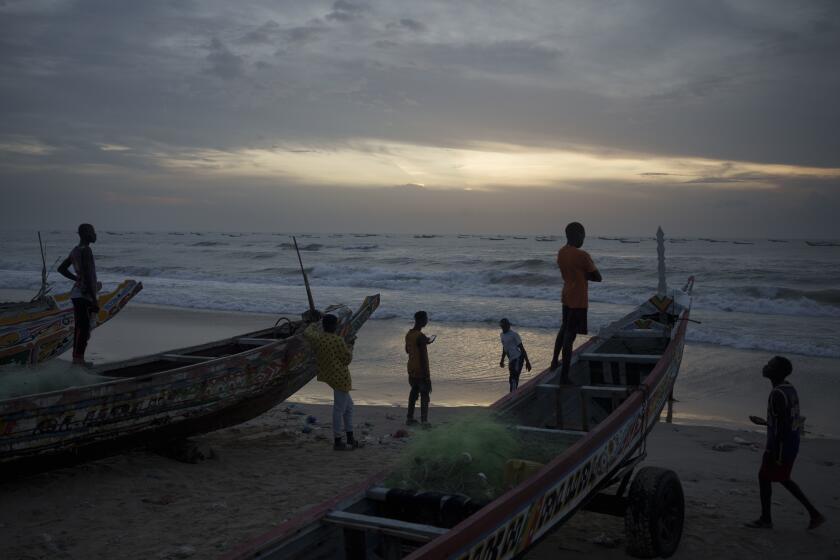‘India’ an exotic hit for TeleFutura
TeleFutura, a Spanish-language network owned by Univision, is taking viewers to another world — one in which heroines’ saris sparkle and some Hindi is spoken.
The network is airing “ India,” a 2009 telenovela imported from Brazil that showcases Indian mores in a story of forbidden love between a low-caste Dalit man and an upper-caste woman. Set in India and Brazil, the soap — originally titled “Caminho das Índias” (Road to India) — sparked a frenzy in Brazil. And TeleFutura is hoping it will do the same here.
“It was definitely a production that caught our attention,” said Bert Medina, the network’s senior vice president and operating manager. “We’re delighted to bring this seemingly different culture to the U.S. Spanish-language media. We wanted to bring a completely different product to our viewers.”
While the number of South Asian TV characters has increased in recent years — “Glee,” “The Good Wife,” “Royal Pains,” “Parks and Recreation,” “30 Rock” “The Office” and “Community” have each featured a South Asian performer — few do much to highlight Indian culture on the screen.
“Slumdog Millionaire,” the Oscar-winning British film set in Mumbai, helped spur recent curiosity. And this fall, NBC’s “Outsourced” inspired debate about its cultural stereotypes.
By acquiring “India,” TeleFutura, which broadcasts to 62.9 million homes in the U.S., is joining in on the “India phenomenon,” Medina said.
The telenovela began airing in October at 10 p.m. Monday through Friday and has averaged about 900,000 viewers, often outperforming Spanish network rival Telemundo’s “Alguien Te Mira” (Someone’s Watching You).
Produced by TV Globo, Brazil’s popular telenovela maker, “India” first broadcast in 2009 to stellar ratings — during its final weeks, it averaged 30 million viewers in Brazil, according to a spokeperson from TV Globo. Medina said its success, along with interest in Indian culture post-”Slumdog Millionaire,” was a catalyst for the decision to acquire the telenovela.
“It was a very interesting process for us,” he said. “There is such a growing fascination with Indian culture in the United States. It felt like a natural move to expand the Indian phenomenon into the Hispanic U.S. community through TeleFutura.”
But Rini B. Mehta, a professor of comparative and world literature at the University of Illinois who co-edited “Bollywood and Globalization: Indian Popular Cinema, Nation, and Diaspora,” worries that the series perpetuates stereotypes and clichés that are ever present in media portrayals of India.
“It is as if it’s a Bollywood production, stripped of historical and political depth,” said Mehta, based on clips she watched online. “Everything is touched on in broad strokes. It’s based on a social concept, the caste system, that is now forbidden. This is not the real India. Even if parts of it were shot there.”
The series was filmed in India, Dubai and Brazil and features Brazilian actors speaking in Portuguese — with snippets of colloquial Hindi — “Arre Baba!” (Oh my goodness!) — sprinkled in. Put the program on mute and the ambiance mimics that of a lavish Bollywood production — palace walls in brilliant colors, sparkly saris and ethnic dances.
“The production is spectacular,” said Carolina Acosta-Alzuru, an associate professor at the University of Georgia’s Grady College of Journalism and Mass Communication. “It’s almost like a film, which isn’t typical of the genre. The cinematic quality heightens the stereotypical elements of a telenovela.”
Acosta-Alzuru, who has studied telenovelas for more than a decade, credits Brazil’s dramas for breaking out of the “traditional Cinderella mode”; that country’s telenovelas incorporate social issues, resulting in passionate followings around the globe.
“Globo has always pushed the envelope with their stories, and they have the money to produce very expensive telenovelas, and it has paid off,” she said. “They do more than tell a love story. They say something about society.”
“India,” a 2009 International Emmy winner, has been dubbed into Spanish for the TeleFutura airings. Like some Spanish-language networks trying to extend their reach beyond their target viewers, the network also offers closed captions of the series in English.
“The goal was to bring our viewers a completely different product,” Medina said. “And ‘India’ is only the beginning.... We are always looking across the globe for properties that people will respond to.”
Even those outside their core audience.
In the days leading up to the series’ October premiere, the network aggressively reached out to the Indian American community by advertising in major Indian American newspapers and distributing fliers in high-density Indian neighborhoods; promos ran in theaters that show Bollywood movies in L.A., San Francisco, Chicago and New York; and a multi-city Yoga in the Park tour was held this summer to spread the word.
“‘India’ is so different than anything on our prime-time lineup,” Medina said. “It’s a sensation for all of the senses.”
More to Read
Sign up for Essential California
The most important California stories and recommendations in your inbox every morning.
You may occasionally receive promotional content from the Los Angeles Times.











